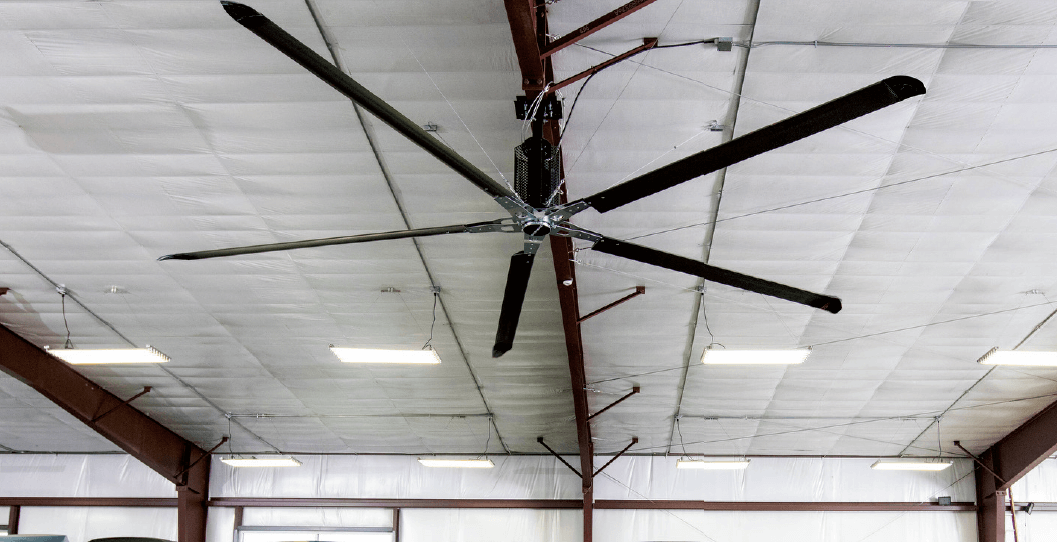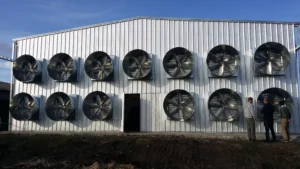HVLS Fans vs Traditional Fans: Which is Better for Your Business - Nowadays, Building a relaxed and productive workplace is important in a competitive industry. Usually overlooked, air circulation plays a critical role in executing this. While standard fans are expected, there may be better solutions for big spaces. High-volume Low-Speed fans offer multiple benefits over conventional fans and have become a game-changer in this esteem.
In this blog, We compare HVLS fans to traditional fans, emphasizing their benefits and flaws. Understanding the unique features of each type will help you make a knowledgeable decision that best fits your business essentials and contributes to a more relaxed, efficient, and affordable workplace.
About HVLS Fans -
HVLS fans are bigger than traditional fans and are developed to induce considerable airflow across large spaces. Despite their size, they work at a low speed, normally ranging from 50 to 125 spins per minute. This intended pace allows for delicate and even air distribution, improving overall convenience without forming awkward drafts. Their distinctive efficiency sets HVLS fans separated as an optimal cooling solution for Business.

Traditional Fans: An Overview -
Traditional fans have historically delivered comfort from the heat. These systems remove warmth from space and substitute it with cool air or ventilate air to form a rejuvenating breeze. Regardless, they also come with liabilities, especially in terms of Cost. These fans can be costly to use, particularly in more extensive areas. Despite their boundaries, these methods stay integral in delivering variable degrees of ease and comfort from the warmth.
HVLS Fans vs. Traditional Fans: Which is Better for Your Business -
Here we share an accurate and detailed comparison between HVLS fans and Traditional fans, which is better for your business or workspace -
| Aspects |
HVLS Fans |
Traditional Fans |
| Airflow Pattern |
Creates a gentle, sweeping breeze that evenly distributes air. |
Creates a direct, concentrated airflow. |
| Airflow Coverage |
Wide area coverage, reaching all corners of the space. |
Limited coverage, often focusing on a specific area. |
| Power Efficiency |
Significantly more energy-efficient, reducing overall energy consumption. |
Less energy-efficient, especially in large spaces. |
| Noise Level |
Extremely quiet, often described as "whisper-quiet." |
Can be quite noisy, especially at higher speeds. |
| Versatility |
Suitable for a wide range of applications, including warehouses, factories, retail spaces, and agricultural facilities. |
Primarily used in smaller spaces or for personal comfort. |
| Cooling Effectiveness |
Effective at cooling large spaces, even in high-ceiling environments. |
May struggle to cool large spaces effectively, especially in areas with high ceilings. |
| Long-Term Cost |
Lower long-term cost due to energy savings and reduced maintenance. |
Higher long-term costs due to increased energy consumption and potential maintenance issues. |
| Initial Cost |
Generally higher initial cost. |
Lower initial cost. |
| Installation |
May require professional installation for larger units. |
Typically easier to install. |
| Maintenance |
Minimal maintenance is required. |
May require more frequent cleaning and maintenance. |
Benefits of HVLS Fans -
Here we explained some major benefits of HVLS fans -
- HVLS fans consume slighter energy analogized to standard fans while delivering superior air circulation.
- These fans help preserve even temperatures, decreasing hotspots and cold zones.
- The gentle breeze created by HVLS fans nourishes convenience without the sensation of powerful winds.
- Decreased power consumption translates to lower utility bills.
Demand for HVLS fans -
The demand for HVLS fans in industries has been rapidly rising in recent years. The global market size for HVLS fans is anticipated to undergo notable growth in the coming years. According to some reports, the HVLS Fans Market size was esteemed at $734.8 million in 2023 and is expected to grow at a CAGR of 5.9% during 2024-2030.
Conclusion -
In conclusion, HVLS fans present power-efficient, peaceful, and effectual cooling for large spaces, making them a convincing choice for different industries. With their minimal keeping requirements and long-term expense savings, HVLS fans are placed as an optimal cooling resolution for businesses looking to create relaxed and effective work conditions.
FAQS for HVLS Fans vs. Traditional Fans: Which is Better for Your Business -
Q.1 What are the critical differences between HVLS fans and traditional fans?
Ans. HVLS fans and traditional fans vary in their airflow pattern, coverage, power efficiency, noise level, versatility, cooling effectiveness, long-term cost, and many more.
Q.2 What are the specific uses for HVLS fans in various industries?
Ans. HVLS fans are typically used in industrial and commercial settings like warehouses, factories, retail spaces, and agricultural facilities.
Q.3 Who is the leading provider of HVLS Fans?
Ans. Bigvent Fans is one of the best providers of HVLS fans and other products at affordable prices with 100% safety and efficacy.
Q.4 What are the distinct uses for traditional fans in industries?
Ans. Traditional Fans are typically used in smaller spaces or for personal comfort.







